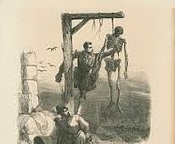What is known today as Poelaert Square, where the colossus, considered to be the largest Palace of Justice in the world, is now known as the Place Poelaert, was not always named after it. It was called… The Galgenberg.
Berg = Mountain, hill. Galgen = Gallow. In the 16th century, on the top of this hill, stood a gallows. It is there, ont he top of the Galgenberg, that, sometimes, those condemned to death were executed in front of the crowds. Far away from the romantic “sight-seeing” walks, the big wheels and the crispy crumbs of today, one could see corpses rotting there after their execution. Sometimes, for several days, they were abandoned after their execution. And left at the mercy of the rats and other vermin that populated the place …
A cheerful atmosphere therefore on the bute overlooking one of the poorest districts of Brussels. And at the beginning of the 16th century, on the sides of this hill, grew the one who is considered today as the first anatomist in History. His name? André Vésale. It is said that it was at the sight of all these cadavers that the young boy’s vocation came to him: He wanted to be a doctor. And he will do everything to become one.
He will then travel to several European countries. Germany, Italy, France,… But it is especially in Paris that he will study and then teach medicine. It is said that in Paris, when he was a teacher, he regularly went to fetch corpses from the gallows of Mont Falcon. He analyzed them, dissected them in order to learn more about human anatomy, which was very little known at the time. In fact, the Church formally forbade the dissection of human cadavers.
A recognition for André Vésale…
After 1547 and the publication of his seminal work “Humani Corporis Fabrica“, a 7-volume treatise on human anatomy that would revolutionize modern medicine, André Vésale would become the personal physician of…… Charles V!
Nice social promotion for the little Brusseleir! But in 1564, on his return from a pilgrimage to the Middle East, his ship was shipwrecked. He died of typhus on a Greek island where he had found refuge. At the age of 49, he left a work unfinished. A taste of too little.
Incredible destiny and sad end for this Brussels native born in a street close to the Sablon: the rue de l’Enfer (which no longer exists today). There is little iconography of Vesalius in Brussels: a statue on the Place des Barricades and a plaque on the rue des Minimes.
We tell you more about this Brusseleir and about the Galgenberg, during our guided tour “Celebrity Brussels“.


Recent Comments